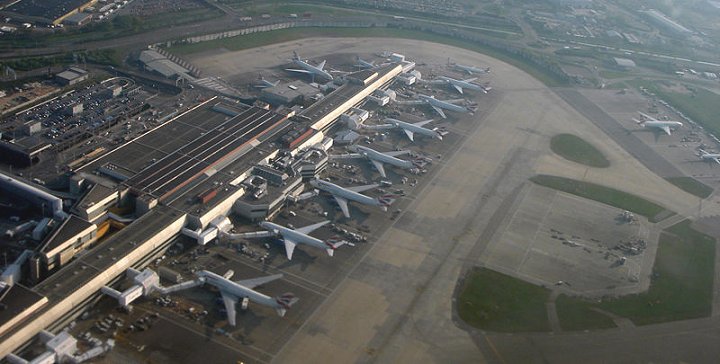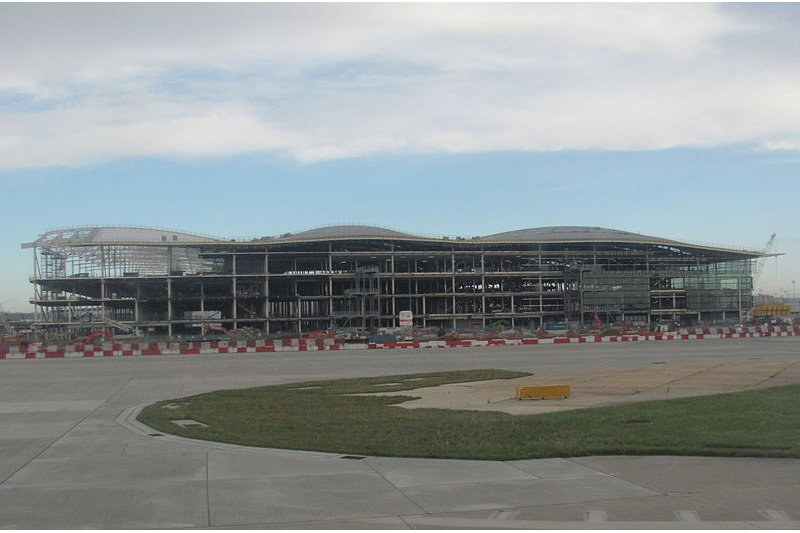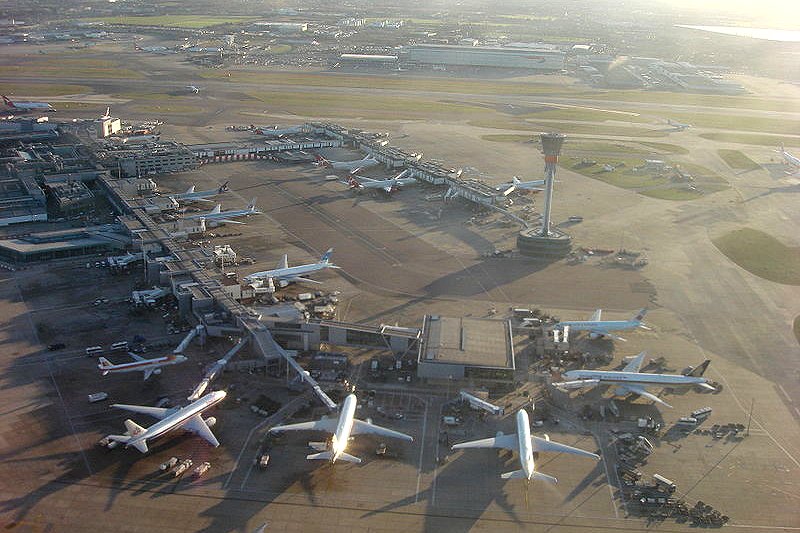 London Heathrow Airport
London Heathrow AirportSource: https://commons.wikimedia.org/wiki/File:London_-_Heathrow_(LHR_-_EGLL)_AN2009298.jpg
Author: Konstantin von Wedelstaedt

London Heathrow Airport (LHR) is the busiest airport in the United Kingdom and one of the busiest in the world. It is located 24 km (15 miles) west of Central London, on the southern end of the London Borough of Hillingdon. It is one of two international London airports located within the Greater London area, the other being London City Airport.
Arriving at London Heathrow you can be in the city Centre in less than an hour with the Heathrow Express or take a connecting flight to a range of other destinations within the UK, including Edinburgh and Manchester.
Heathrow Airport on Google Maps Street View
Arriving at London Heathrow
Before you arrive at London Heathrow Airport, find out the terminal building you are arriving in. Heathrow Airport, officially London Heathrow (LHR), is the biggest of the five airports serving London, and is also one of the biggest airports in the world. A sprawling complex, London Heathrow comprises five terminal buildings, and getting around them can be quite complicated, especially if you are a transiting passenger.Three of the terminals of London Heathrow, T1, T2, and T3, are located around one another. T4 is located on the southern part of Heathrow Airport while the newly opened T5 is located to the west. The terminals are served with a variety of transport links including rails, bus and taxis, with parking space which are quite limited.
The procedure through London Heathrow is quite straightforward, and can be summarized into the following steps:
1. Upon getting out of the aircraft, follow the sign pointing to Arrivals
2. Go through Passport Control. There are two sections, one for nationals of EU and Britain, another for all other nationals. You will be expected to show a valid passport which will not expire during your stay in the United Kingdom. Please be aware that some times, it may take a while to go through Passport Controls when the queues are long.
3. Once out of Passport Control, follow the sign to Baggage Reclaim. Look for the right carousel by your Flight Number on the Information Screens. Trolleys are available for your use. Your airline is responsible for your luggage until you pick it up. If it is damaged or missing, contact your airline representative.
4. Having collected your baggage, go through Customs Clearance. If you arrived from a European Union country, use the blue exit. If you arrived from a non-European Union country, use the green channel if you have nothing to declare. Otherwise, or if you're in doubt, use the red channel.
5. You exit Customs into Heathrow's Arrival Concourse. A variety of transport options are available for you to leave the airport.
Getting Out of London Heathrow Airport
You have many different transport options to leave Heathrow Airport. This includes taking the train, the bus, taxi and by car.Leaving Heathrow by train
Heathrow Airport is connected to London by at least three different rail links:
- Heathrow Express is a high-speed train that connects Heathrow Terminals T1, T2, T3 and T5 with London Paddington railway station. Heathrow Express does not serve Terminal T4. By taking the Heathrow Express, you can be in the middle of London within 15 minutes from T1/2/3 and 23 minutes from T5. The train runs once every 15 minutes and costs £14.50 one way, when booked online, and £28.00 return. First class tickets are also available at £23.50 one way and £46.00 return. First class features quicker, easier access to the terminals, more leg room, uninterrupted mobile coverage/Internet Wi-Fi and complimentary papers. To book your ticket, go to the Heathrow Express website, www.heathrowexpress.com
- Heathrow Connect is a train connecting Heathrow Terminals T1, T2, T3 and T4 with London Paddington Station. It is slower than Heathrow Express, as it makes stops at stations between Heathrow and Paddington (see map). The journey between Heathrow Central and Paddington takes 25 minutes and the train runs once every half an hour. The fare is also lower. It is £6.90 one way, £11.90 return, and £12.90 for open return day. Heathrow Connect does not go to Terminal 5, but passengers of Heathrow Connect may then board the Heathrow Express at Central Heathrow station (which serves Terminals 1, 2, 3) for the journey to Terminal 5 for free. For more details, visit the Heathrow Connect website, www.heathrowconnect.com
- Piccadilly Line This is a line on the London Underground, also called the Tube. The Piccadilly Line is dark blue on the Tube map. Taking the Tube is the cheapest as well as slowest of the three rail options - it should cost you only £3.50 - £4.80 using the Oyster Card, but will take about an hour to reach Central London. It makes numerous stops, so the benefit is that you can get down at a stop nearest to your destination.
Coach Services
1. National Express, a leading public transport provider, runs a regular bus service between Heathrow Central Bus Station (CBS) and the Victoria Bus Station (next to London Victoria railway station). Heathrow CBS is located between Terminals T1, T2 and T3. There is an underground walkway that connects the Heathrow CBS to the three terminals. The buses also stop at Terminals T4 and T5. Alternatively, you can get a free ride on the Heathrow Express and Heathrow Connect to Heathrow Central, to take the buses there.
A journey from Heathrow CBS to Victoria Bus Station takes between 40 minutes to an hour, unless there is a massive jam. An Economy Single ticket between Heathrow CBS and Victoria Bus Station is £4.00.
Passengers are allowed to carry on board 2 medium-sized suitcases weighing a maximum of 20kg each, and one piece of hand luggage that can fit into the overhead compartment. To book a ticket for the bus, go to the National Express website, www.nationalexpress.com.
Local Buses
Taking the local bus is a low-cost alternative for leaving Heathrow Airport. There is an extensive network of local buses that ply routes between Heathrow and the towns in west London. The single adult fare for taking the local bus is £2.00, and the Oyster Card can be used. (Click here for information on the bus tickets, called Travelcard and Oyster Card.)
Leaving Heathrow by car
Heathrow airport is located approximately 27 km (17 miles) west of Central London. Terminals 1, 2 and 3 are located together, and the centre of the airport. Terminal 4 is located to the south side of Heathrow while Terminal 5 is located on the west side of Heathrow. The main motorway from Heathrow airport to Central London is the M4. From Terminals 1, 2 and 3, exit the M4 at Junction 4. The airport is located to the south of M4.
To reach Terminal 4, exit the M4 at Junction 3, take The Parkway (A312) south and then turn right into the Great South-West Road (A30). Follow signage towards Terminal 4.
To reach Terminal 5, exit the M4 at Junction 4b into M25. Then exit M25 at Junction 14.
If you are using GPS / satellite navigational system, these postcodes will be useful:
Terminal 1: TW6 1AP
Terminal 2: TW6 1EW
Terminal 3: TW6 3QG
Terminal 4: TW6 3XA
Terminal 5: TW6 2GA
Car Rental at Heathrow Airport
The following car rental companies operate out of Heathrow Airport. Prices should be around £15-£20 per day excluding petrol.
- Hertz: www.hertz.co.uk
- Avis: www.avis.co.uk
- Europcar: www.europcar.co.uk
- National: www.nationalcar.co.uk
- Alamo: www.alamo.co.uk
- Enterprise: www.enterprise.co.uk
- Budget: www.budget.co.uk
- Guy Salmon: www.guysalmon.co.uk
There are three petrol stations around Heathrow Airport:
- BP Station located at Heathrow Central close to Terminal 1, 2, and 3
- BP Station at Hatton Cross, Great West Road (A30)
- Esso Station at the South Perimeter Road
Taking the taxi is probably the most expensive public transport option out of Heathrow. The ubiquitous London Black Cab can be hired for the trip, and will set you back between £40-£70. The advantage of taking the cab is that you are taken right to the doorstep of your destination. As with all vehicular transports, you risk getting caught in a traffic jam. If the traffic is smooth, expect to reach London within 30 minutes to an hour.
All the taxis accept cash and some even credit cards. You can find a taxi stand at each of the five Heathrow terminal buildings.
 London Heathrow Terminal 2
London Heathrow Terminal 2Source: https://commons.wikimedia.org/wiki/File:Construction_%C3%A0_London_Heathrow_Airport.jpg
Author: Benoit Prieur

Terminal Transfers
You can transit between Terminals 1/2/3 and Terminal 5 on the Heathrow Express for free. To transit between Terminals 1/2/3 and Terminal 4, use the Heathrow Connect for free.Heathrow has two parallel main runways and four functional terminals with the next one, Terminal 5, expected to operate from March 2008. Some of the existing terminals have been earmarked for redevelopment. Heathrow East terminal, expected to come into operation in 2012 will replace Terminal 2 and The Queens Building.
Heathrow Airport started as the Great Western Aerodrome in the 1930s, on land originally acquired from the vicar of Harmondsworth. It was named after the hamlet of Heath Row, which was cleared to make way for the airport - it is located approximately where Terminal 3 now stands. At that time, Croydon Airport was the main airport serving London.
Construction of the first modern runway at Heathrow Airport commenced 1953. The first permanent terminal building, then called Europa Building, but now Terminal 2, was opened in 1955. Following that, Oceanic Terminal, now known as Terminal 3, opened on 13 November 1961. Terminal 1 completed the cluster of terminal buildings at the centre of Heathrow Airport when it opened in 1968.
 London Heathrow Terminal 3
London Heathrow Terminal 3Source: https://commons.wikimedia.org/wiki/File:Heathrow_Airport_010.jpg
Author: Panhard

The siting of these early terminals reflected the lifestyle at that time. There was little space given to parking, because at that time air travel was affordable onto to the wealthy, who would be chauffeur driven. The location of Heathrow, to the west of London, was also a poor choice. Westerly winds require airlines to fly low over the city for much of the year, something that is avoided by other European cities such as Amsterdam and Frankfurt.
The London Underground was extended to Heathrow in 1977, allowing travellers to reach Central London in under an hour. The Heathrow Express train came into operation in 1998, cutting down travel time to Paddingtom station to only 15 minutes. Terminal 4, built away from the three older terminals, opened in 1986 and became the new home for British Airways.
Although Heathrow originally had six runways, today it only two parallel runways. To accommodate the introduction of Airbus A380, Pier 6 at Terminal 3 was modified. The new Terminal 5 will also be able to accommodate the A380.
Heathrow Airport claims itself to be the "world's busiest international airport". While it indeed has the highest international passenger numbers, in terms of total passenger traffic, it ranks third after Atlanta-Hartsfield-Jackson and Chicago-O'Hare in the United States. In 2006, Heathrow gets 18.8% more passengers than Paris Charles de Gaulle Airport and 27.9% more than Frankfurt Airport. However, in terms of plane movements, it is third behind Charles de Gaulle and Frankfurt.
List of Airports in London and Airports in the United Kingdom
 Latest updates on Penang Travel Tips
Latest updates on Penang Travel Tips
 Discover with Timothy YouTube Channel
Discover with Timothy YouTube Channel
 PG Food Channel
PG Food Channel
 Learn Penang Hokkien YouTube Channel
Learn Penang Hokkien YouTube Channel
 SojiMart Videos
SojiMart Videos
Latest from Discover with Timothy: Gurney Bay - what to see and do there
About this website

Hello and thanks for reading this page. My name is Timothy and my hobby is in describing places so that I can share the information with the general public. My website has become the go to site for a lot of people including students, teachers, journalists, etc. whenever they seek information on places, particularly those in Malaysia and Singapore. I have been doing this since 5 January 2003, for over twenty years already. You can read about me at Discover Timothy. By now I have compiled information on thousands of places, mostly in Peninsular Malaysia and Singapore, and I continue to add more almost every day. My goal is to describe every street in every town in Malaysia and Singapore.
Robbie's Roadmap
- Episode 1: Robbie's Journey to Financial Freedom
- Episode 2: Lost in America
- Episode 3: The Value of Money
- Episode 4: The Mentor
- Episode 5: The Thing that Makes Money
- Episode 6: The walk with a Billionaire
- Episode 7: The Financial Freedom Awakening
- Episode 8: Meet Mr Washington
- Episode 9: The Pizzeria Incident
Copyright © 2003-2024 Timothy Tye. All Rights Reserved.


 Go Back
Go Back